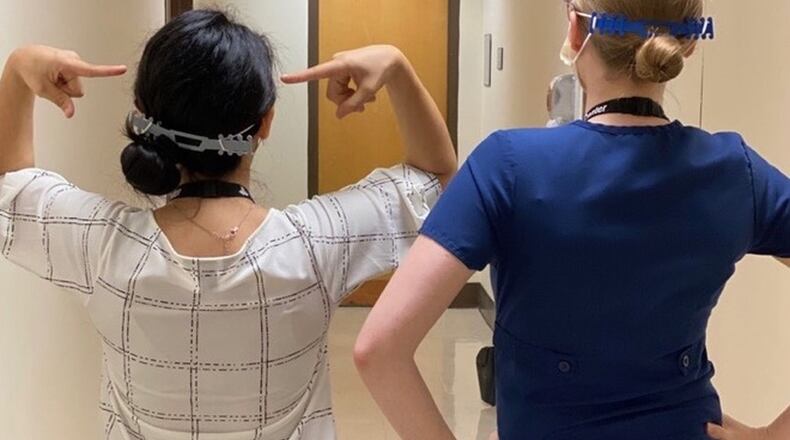A high school class that requires to students to use math and science skills in practical applications is helping frontline workers in the fight against the coronavirus.
Manufacturing students at Gwinnett County’s Maxwell High School of Technology have developed an accessory to make the medical face shields worn by health care workers more comfortable.
“Face shields are typically used as personal protective equipment to protect the wearer’s eyes, nose and mouth from splashes, sprays and spatter, said Sandy Bozarth, manager of infection prevention and control at Northeast Georgia Health System in Gainesville. “All NGHS staff wear them when caring for patients who might have flu, RSV or other diseases that are spread when the patient coughs or sneezes.”
According to CDC guidelines, health care workers caring for patients confirmed or suspected to have COVID-19 should wear gloves, a gown, an N-95 mask and goggles or a face shield.
“We are choosing to use face shields instead of goggles because they also help protect the outside of the N-95 and surgical masks so they don’t get as dirty as fast. In other words, face shields help us reduce the number of masks used by staff,” Bozarth added.
But the large, see-through plastic face shields can leave the wearer with red, sore, irritated skin as well as bruises and abrasions. Although the face shields appear to be effective in protecting wearers from contracting the virus, they weren’t originally meant to be worn all day. After prolonged use they can become quite irritating.
RELATED STORY: Gwinnett announces plans to end school year
RELATED STORY: Manufacturing work doesn't mean low pay, students find
A friend who works in health care asked Brandon Myers, manufacturing instructor at Maxwell, if his students had ideas on how to make the gear more comfortable. Many have tried tape where the skin comes into contact with the equipment or other means to lessen the friction. Finding design and manufacturing solutions for today’s problems is the mission of the manufacturing program, said Myers, so the students got busy devising a way to help.
“The problem is mainly in the fit,” said Myers.
The add-on the students came up with has small bars on either side of the plastic buckle to hold the elastic taut behind the mask-wearer’s head, so that it doesn’t put painful pressure on the ears. And because it fits better, the shield stays put longer.
“This product started out as part of a project for low-cost prosthesis that can be assembled and disassembled quickly,” said Myers. “The students made modifications and in two days they had a design that worked for the face shields.”
The device wasn’t the only contribution from students and others.
“When we asked the community to help with 3D printed face shields and ear pieces, we received an overwhelming response,” said Chris Dearwent, athletic training manager for Northeast Georgia Physicians Group. “So far, local schools and business have produced over 700 face shields for our front-line workers. Our employees are especially grateful for these donations and all of the community support being shown during this time.”
Myers runs the class like a real company.
“The teacher is the CEO and the students are the designers and engineers. They use their problem-solving skills to find solutions. I don’t give orders to just make parts.”
Depending upon the size of the ear strain reliefs, 3D printers can make nine of the smaller ones or six of the larger ones in three hours. With six machines, that’s as many as 54 in three hours.
Right now that the classes are practicing social distancing, Myers is one-man production crew. The students upload specs into the cloud and he makes the adjustments and pushes the buttons.
“The process is completely organic and authentic,” said Myers.
Just before school went to online-only, his classes were producing products and shipping them to clients.
“There are so many practical applications for these skills,” said Myers. “I have students who are interested in bio-medical fields, engineering and some who want to go straight to manufacturing out of high school. They all work together as a team the same way it happens in real life.”
About the Author
Keep Reading
The Latest
Featured



